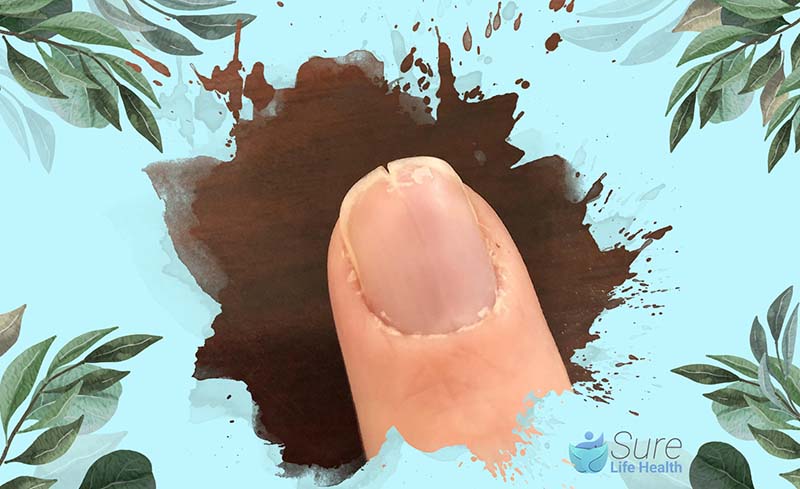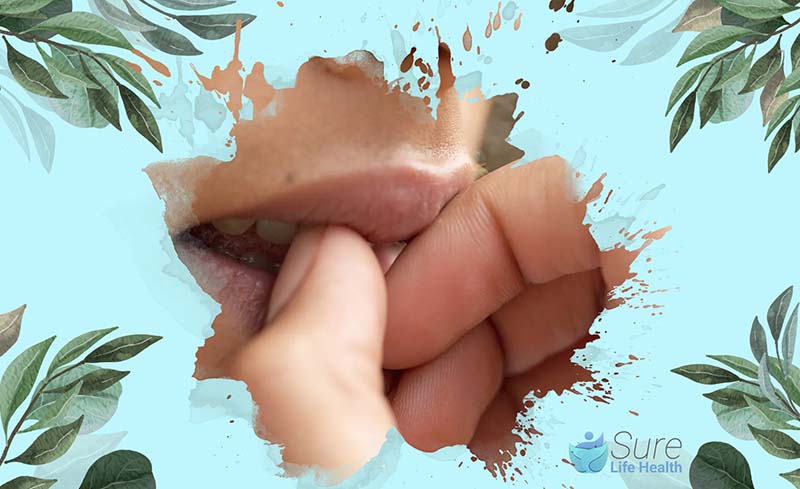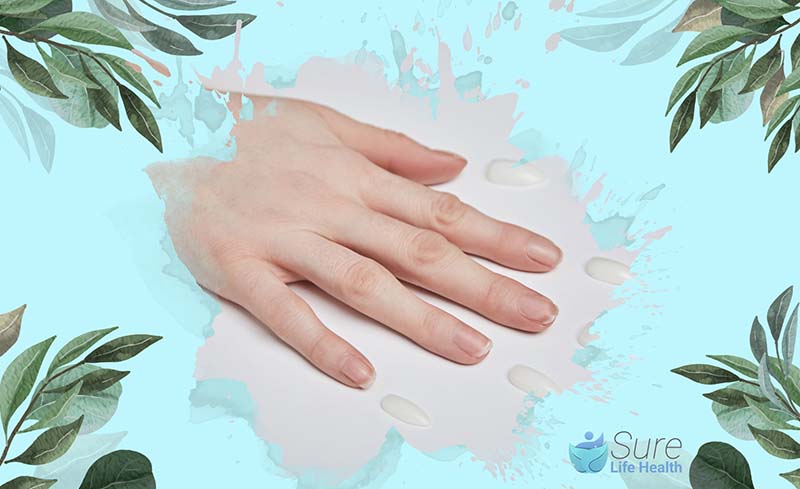Have you ever looked down at your hands and noticed a split nail? Do you know how to fix a vertical split nail? Keeping your nails healthy is crucial to avoiding these issues.
However, if you’re currently dealing with a split nail, it’s important to understand the reasons behind as well how to handle this inconvenience.
Let’s explore this topic further to clear up any questions you might have

Reasons Why Nail Split Down the Middle Vertically
There are various reasons why nails may split, medically referred to as onychoschizia. Here are some common causes:
Nail Polish
While a fresh manicure may enhance your look, frequent use of nail polish and removers can weaken your nails over time. Even gel acrylics can contribute to nail splitting. Taking breaks from nail cosmetics allows your nails to recover and helps prevent splits.
Vitamin Deficiency
Insufficient intake of essential vitamins like biotin, iron, or calcium can lead to nail splitting. Pregnant individuals, in particular, may experience this due to increased nutritional demands. Incorporating vitamin-rich foods or supplements can aid in nail health.

Aging of the Body
Nails undergo changes as we age, growing slower and becoming more prone to splitting and discoloration. Supplements containing biotin and collagen are often used to support nail health in older individuals.
Exposure to Moisture
Hydrated nails are healthy, but excessive exposure to moisture weakens them. Activities like prolonged swimming, frequent dishwashing, or prolonged soaking in bathwater can lead to weakened nails prone to splitting. Additionally, frequent use of nail polish remover can contribute to this issue.
Nail Psoriasis
Psoriasis, a skin condition characterized by red, scaly patches, can also affect nails, causing weakening and splitting. Nail psoriasis may manifest as nail pits, discoloration, or crumbling nails, making them more prone to splitting.
Nail Biting
Anxiety-induced nail biting or picking can weaken nails, making them more susceptible to splitting. Consistent biting or picking diminishes nail strength over time, increasing the likelihood of splits.

Nail Injury
Accidental trauma to fingers and fingernails, such as catching them in doors or pinching them, can cause splits. Depending on the severity of the injury, it may also affect the nail bed.
Chemotherapy
Medications used in chemotherapy target fast-growing cells, including nail cells, leading to brittle and splitting nails. While effective in slowing cancer cell growth, chemotherapy can inadvertently damage normal fast-growing cells like nails and hair.
Understanding these causes can help in implementing preventive measures and seeking appropriate treatment if necessary.
How to Repair a Split Nail Down the Middle
When dealing with a split nail down the middle, there are several home remedies you can try to repair it until it grows out. Here are some options:
Use Fake Nails
You can opt to use a fake nail to either remove the splitting piece or leave it in place. Apply the fake nail solely to the broken nail or to all nails for uniformity.

Use Tea Bags
To fix a split nail, you can use a piece of a regular tea bag. Cut it to the size of your nail and attach it with nail adhesive. After the adhesive dries, smooth the nail with a buffer and apply nail polish if desired.
Use Nail Glue
Another method is to use nail glue. Apply a small amount to the split, press the nail pieces together gently until the glue dries, and then apply nail polish to conceal the repair.
Gel And Silk Wraps
Another method is to use nail glue. Apply a small amount to the split, press the nail pieces together gently until the glue dries, and then apply nail polish to conceal the repair.
Medical Treatment
In certain cases, medical intervention may be necessary. For instance, if the split nail is due to conditions like psoriasis, controlling the underlying condition with medication can help prevent further nail damage. Acute infections caused by fungi, yeast, or bacteria may require antifungal or antibiotic treatments to prevent additional nail damage.
These home remedies offer practical solutions to repair split nails and improve their appearance until they naturally grow out. However, if you suspect an underlying medical condition or if the split nail persists despite home remedies, it’s advisable to seek professional medical advice for appropriate treatment.
How to Prevent Nails from Splitting Vertically Down the Middle
While it’s not always possible to completely prevent split nails, certain precautions and lifestyle adjustments can help minimize nail damage. Here are some tips to prevent vertical splitting down the middle of nails:
- Maintain a Healthy Diet: Ensure your diet is rich in vitamins and minerals, as adequate nutrition supports overall nail health. While split nails rarely result from poor nutrition, maintaining a balanced diet can contribute to nail strength.

- Consider Biotin Supplements: Biotin, a B vitamin, promotes healthy nails. However, it’s important to consult with a doctor before starting any supplement regimen.
- Moisturize Regularly: Keep your nails and cuticles moisturized to prevent them from becoming dry and brittle, which can lead to splitting. Use a nourishing nail or cuticle oil regularly.
- Limit Water Exposure: Excessive exposure to water can weaken nails. Try to minimize prolonged contact with water, especially hot water, and moisturize your nails after exposure.
- Take Protective Measures: Wear gloves when using cleaning chemicals or washing dishes to shield your nails from harsh substances and excessive moisture.
- Avoid Harsh Nail Products: Steer clear of harsh nail polish removers containing acetone, as they can strip the nails of moisture and weaken them. Opt for gentler, acetone-free formulas instead.
- Recover From Nail Cosmetics: Give your nails periodic breaks from nail polishes and gels to allow them to recover and strengthen naturally.
- Handle Hangnails Carefully: Refrain from pulling or biting hangnails, as this can cause further damage to the nails and surrounding skin.
- Be Cautious During Activities: When engaging in manual tasks or activities that may stress the nails, such as gardening or DIY projects, wear protective gloves to prevent damage.
Incorporating these preventive measures into your nail care routine can help maintain the health and strength of your nails, reducing the likelihood of vertical splitting down the middle.
When to Contact Doctor
If you experience severe nail splits or notice any concerning symptoms, it’s advisable to seek medical attention from a healthcare professional. If you notice any of these signs, it might be a good idea to contact a doctor:
- Distorted Nails: If your nails appear distorted or exhibit unusual shapes or textures, it could indicate an underlying issue that requires medical evaluation.
- Changes in Nail Color: A bluish or purplish coloration of the nail can sometimes indicate poor circulation or other medical conditions. Seeking medical advice can help determine the cause and appropriate treatment.
- Ingrown Nails: Ingrown nails occur when the nail grows into the surrounding skin, leading to pain, inflammation, and potential infection. Prompt medical intervention can alleviate discomfort and prevent complications.
- Painful Nails: Persistent pain or discomfort associated with your nails may signal an underlying problem, such as infection or injury, which requires assessment and treatment by a healthcare professional.
- Appearance of White Spots: The development of white spots or patches under the nails could indicate various nail disorders or fungal infections, necessitating medical evaluation for proper diagnosis and management.
- Horizontal Ridges: Horizontal ridges or indentations on the nails, known as Beau’s lines, may be indicative of systemic conditions or significant stress on the body. Consulting a doctor can help determine the underlying cause.
In cases where severe nail splits are present, a healthcare professional may need to intervene by removing the nail, suturing the nail bed, or reattaching the nail using stitches or glue. If you observe any of the aforementioned symptoms or have concerns about the health of your nails, don’t hesitate to contact a doctor for further evaluation and appropriate medical treatment.

FAQs
How Can I Strengthen My Nails to Prevent Splitting?
Strengthening your nails involves consistent care, moisturization, and a nutritious diet rich in vitamins and minerals.
Additionally, you can explore nail strengthening products and essential oils to further support healthier, stronger nails.
Can I Still Wear Nail Polish If My Nails Are Prone to Splitting?
While it’s possible to wear nail polish, it’s best to opt for gentle, moisture-rich formulations or nail strengthening products to minimize damage.
Remember to give your nails periodic breaks from nail cosmetics and choose acetone-free nail polish removers whenever possible.
Can Certain Medications Cause My Nails to Split or Become Brittle?
Yes, certain medications, such as chemotherapy drugs, retinoids, antifungal medications, and blood thinners, can have side effects that affect nail health, leading to splitting or brittleness.
If you’re concerned about the effects of a particular medication on your nails, it’s important to discuss this with your healthcare provider. They can explore alternative options or provide additional supportive measures to mitigate the impact on your nails.
Conclusion
In conclusion, understanding the various factors that contribute to splitting nails is crucial for maintaining their health and strength. By addressing underlying causes and adopting proper nail care practices, we can effectively prevent and manage nail splitting. Knowing when to seek medical assistance and recognizing potential complications is essential for ensuring optimal nail health.
Taking proactive steps to care for our nails and minimize damage is imperative, as our nails not only enhance our appearance but also serve a protective function for our fingertips. With diligent care and attention, we can keep our nails healthy, strong, and aesthetically pleasing, thus promoting overall well-being and confidence in our fingertips.
Be sure to explore more insightful blogs from Sure Life Health, where we continue to shed light on the latest trends and breakthroughs in health and wellness.
Professor Gaye Cunnane, PhD, MB, FRCPI
As the Director of Health and Wellbeing at RCPI, Professor Gaye Cunnane is at the helm of initiatives aimed at enhancing the health and well-being of RCPI Trainers and Trainees. Her role extends beyond administration; she is also a respected clinical professor of rheumatology and a consultant rheumatologist at Trinity College Dublin (TCD) and St James’s Hospital. Prof. Cunnane’s medical journey began at TCD, where she graduated from medical school, and her path has been marked by both clinical and academic excellence.
After completing her basic clinical training in medicine, she embarked on PhD studies at University College Dublin and St Vincent’s University Hospital. Her research during this period was focused on prognostic markers in early inflammatory arthritis, a project that saw her collaborating with esteemed universities across Europe, including in Switzerland, The Netherlands, the UK, and Sweden.
Prof. Cunnane’s career took her to the University of California, San Francisco, where she spent three years delving into research on new treatments for lupus. Her academic prowess led her to the University of Leeds in 2001 as a senior lecturer, before returning to Ireland in 2003 to assume her current roles. She has also served as the National Specialty Director for Rheumatology training in Ireland, Programme Director for Basic Specialist Training with RCPI, and as a past President of the Irish Society for Rheumatology.
PUBLISHED ARTICLES
“Rheumatic disease differentiation using immunoglobulin G sugar printing by high-density electrophoresis”: Published in The Journal of Rheumatology, this study reflects her in-depth investigation into rheumatic diseases.
“Benefits of exercise in patients with rheumatoid arthritis: a randomized controlled trial”: This research work, highlighting the positive impact of exercise on rheumatoid arthritis, underscores Prof. Cunnane’s dedication to practical, patient-centered research.
Additionally, Prof. Cunnane has made notable contributions to the Annals of the Rheumatic Diseases, discussing early referral, diagnosis, and treatment of rheumatoid arthritis. She has also been involved in a study on the NCBI platform investigating exercise benefits in rheumatoid arthritis patients.
Professor Gaye Cunnane’s career is a testament to her commitment to improving patient outcomes in rheumatology through rigorous research, clinical excellence, and dedicated teaching. Her work continues to influence the field of rheumatology, both in Ireland and internationally.

